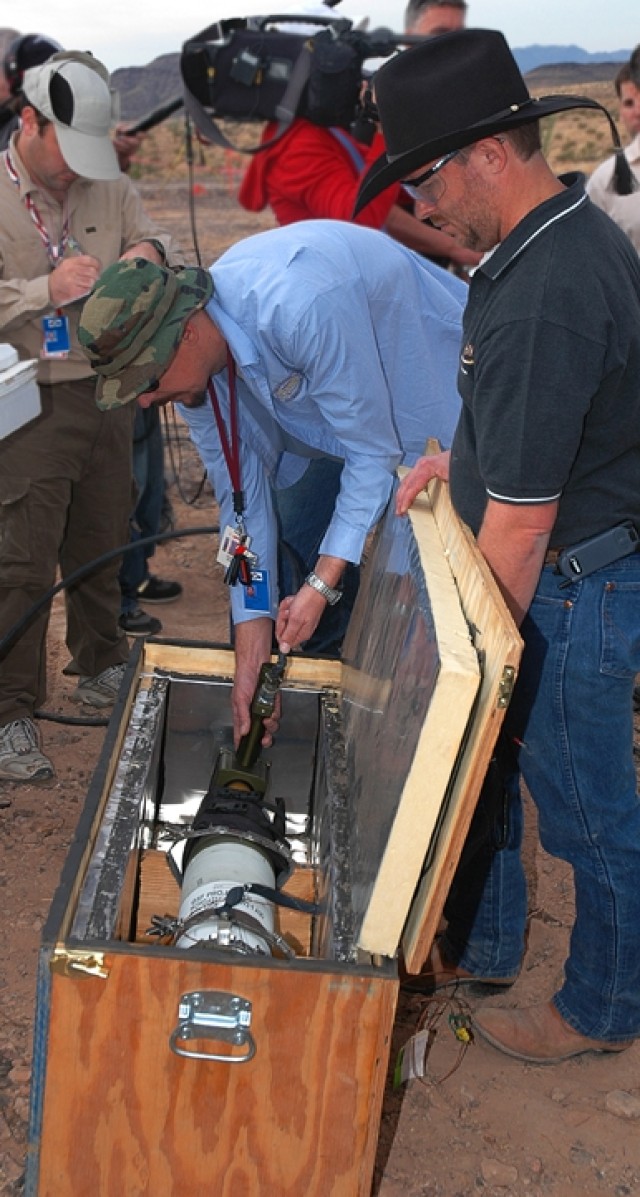YUMA PROVING GROUND, Ariz. (Army News Service, Feb. 15, 2008) --The Developmental Test Command at Yuma Proving Ground has conducted a considerable workload of testing to help the Army develop weapon systems and munitions to fight the war on terror
Tests of the Family of Joint Precision Airdrop Systems, or JPADS, has resulted in limited fielding of the Screamer, Firefly and the Affordable Guided Airdrop System, or AGAS, in the Iraq and Afghanistan theaters.
JPADS is a family of systems that have different weight ranges which will allow conventional military aircraft to accurately drop sensors, munitions, and/or a huge range of supplies onto the battlefield while minimizing risk to the aircraft and the possibility of enemy detection of aircraft drop zones. The systems will use gliding parachute decelerators, GPS-based guidance, navigation and control, weather data assimulation and an airdrop mission planning tool to deliver cargo with near pinpoint accuracy.
The Screamer 2K allows a fast GPS-guided decent before it reaches destination and altitude requirements. Then it deploys another parachute that allows for a soft landing of the cargo.
Firefly is a 2,000-pound JPADS that uses a ram-air parachute or self-inflating airfoil, known as a parafoil, that provides control of drop speed and direction.
The components of the AGAS system include electromechanical actuators which adjust the length of the parachute risers in order to steer the canopy. A GPS sends signals to the actuators to compensate for fluctuations in the wind. The actuator and GPS work together to guide the load to the ground. A windpack dropsond,e resembling a small torpedo attached to the parachute measures wind data and distance to the drop zone. AGAS uses a standard Army cargo parachute and A-22 container, capable of holding 2,200 pounds of equipment.
JPADS testing began two years ago and will continue well into the new fiscal year, officials said. AGAS testing began about five years ago and continues as part of the JPADS program, they said.
Sixteen flight sorties and more than 90 airdrops of the Low Cost Low Altitude Airdrop Systems took place at Yuma over a two-week period in September. The testing provided safety verification of this technique using five different parachute configurations and will lead to a safety confirmation allowing these configurations to be used in theater, officials said.
The Army was able to significantly upgrade software for the Kiowa Warrior helicopter during a recent six-month test period, officials said. The Aviation Technical Test Center at Redstone Arsenal, Ala., jointly conducted the testing with Yuma Test Center, resulting in a safety confirmation to allow fielding of multiple software and hardware configurations as the fleet is retrofitted to replace obsolete parts and provide some additional weapons and communications capabilities. Additional testing is slated for the new fiscal year.
<b>Munitions and Weapons</b>
The test program for the Counter-Rocket, Artillery, Mortar, or C-RAM System of Systems spanned several years, from the initial concept to production-verification testing of deployed systems. The C-RAM System of Systems provides sense, warn, intercept, command and control, and respond capabilities, protecting forward operating bases in theater from hostile rocket and mortar fire.
Testing of the XM982 Excalibur Precision Engagement projectile continues at the proving ground, officials said. In November 2006, testers at Yuma successfully completed all production-verification and first-article tests in time to support a recommendation for safety release. This allowed Soldiers from the 1-76th Field Artillery to participate in a "Limited User Test," or LUT. The Yuma test team was responsible for meeting strict timelines and for coordinating LUT requirements with personnel from the Operational Test Command; Program Manager, Excalibur; and the Army's Integrated Product Team. The Army approved the urgent materiel release for the XM982 Excalibur projectile in March 2007, and troops are now successfully using the Excalibur in theater.
<b> Combat and Automotive Systems</b>
Over several months, the test center has conducted a diverse range of testing for tracked and wheeled tactical vehicles, along with ancillary equipment, directly contributing to the fight against terrorism.
Yuma Test Center also tested the automotive safety and endurance of several Mine Resistant Ambush Protected, or MRAP vehicles from different vendors, to support rapid fielding of the vehicle to the combat theater. This also made them ready to undergo the MRAP "Initial Operational Test and Evaluation," or IOT&E in military jargon, to be conducted at Yuma.
Yuma Test Center and operational testers also conducted several joint tests of the RG-31 Medium Mine Protected Vehicle to assess vehicle capabilities with bar armor and a remote weapon system. Testing of the Self Protection Adaptive Roller Kit, or SPARK mine roller addressed the effectiveness of the SPARK on several vehicles. The system consists of a Pearson mine roller fitted to tactical vehicles to counter explosive threats. SPARK testing has been earmarked for numerous vehicle platforms, officials said.
Testing of the Stryker Mobile Gun System, known as MGS, resulted in a recommendation for safety confirmation and fielding of the first vehicles to four Stryker Brigade Combat Teams for use in their deployment to Operation Iraqi Freedom. Testing focused on system reliability and environmental performance, and on evaluating the numerous changes in this weapons platform since its first introduction.
Recently concluded testing of the Stryker Full Spectrum Effects Platform, also known as the "Sheriff," addressed an urgent operational need for a single weapons platform that could deploy lethal and non-lethal responses to threats. Testing focused on reliability, safety and environmental performance to support a safety confirmation.
Testers at Yuma also tested software developed for the Bradley Fighting Vehicle, resulting in a recommended safety confirmation. Testing took place over two weeks, and the safety recommendation was staffed within one week of the final test. Without the safety recommendation, officials said the system may have missed the deployment schedule, causing a tremendous logistical burden,.
<b>Counter-Insurgency </b>
During fiscal year 2007, Yuma Proving Ground's National Counter-Terrorism/Counter-Insurgency Integrated Test and Evaluation Center conducted more than 190 tests in support of counter-improvised-explosive- device and counter-terrorism technologies, totaling more than 587,000 direct man-hours of labor for these test projects, including both evolving technologies and currently fielded systems.
Coordinating with subject-matter experts and personnel at higher headquarters, officials said the proving ground provides a comprehensive reach-back test capability for specific theater test requests. They said this rapid test capability in controlled conditions helps the Army maximize the performance of currently fielded systems in Iraq and Afghanistan.
Teaming up with the Electronic Proving Ground and the Intelligence and Electronic Warfare Test Directorate at Fort Huachuca, the proving ground provides full-spectrum testing, including system performance, interoperability and friendly force communications for all potential, pending and currently fielded counter-IED and counter-terrorism technologies.






Social Sharing